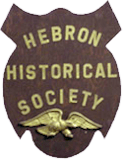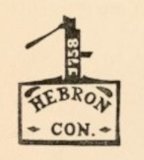
The Hebron Historical Society
Hebron, Connecticut
Enjoy Hebron - It's Here To Stay ™


Enjoy Hebron - It's Here To Stay ™

This Historic Diversity and Archeological Sites Map represents just a sample of the diverse people that have called Hebron home throughout history. Beginning with the arrival of the Paleoindians between 12,500 and 9,500 years ago, many Indigenous cultures lived in Hebron and thrived among its lush forests, grasslands and waterways. In 1675, large tracts of land in the area were bequeathed to English settlers in the will of Attawanhood, also known as Joshua, the son of the Mohegan Sachem Uncas. The first colonial settlements were organized in 1704 and centered along an old Indian path known to the settlers as “the Country Road,” today known as Church Street / Route 85. Hebron was incorporated as Connecticut’s 41st town in 1708 and was soon home to a variety of colonial settlers.
It is unknown when the first enslaved African American was brought to Hebron, but according to Yale University there were 2,600 enslaved African Americans in Connecticut by 1740. By 1774, there were approximately 5,100 enslaved people in Connecticut, most of them owned a few in a household of middle-income farmers. In 1784 and 1797, Connecticut established laws providing for the gradual emancipation of enslaved people. By 1820, the United States Census reported 48 enslaved people and 7,870 Free Non-White people living in Connecticut. Hebron became home to an important community of free Black farmers, including the noted Cesar Peters and his sons, as well as others. Also arriving in Hebron in the mid and late 19th century was the first wave of European immigrants, including Irish, Italians and Eastern Europeans hired to work in the mills.
Hebron also has a unique history of being home to an important community of people with disabilities that were actively integrated into society in the 18th and early 19th centuries. Among them was the family of Hon. Sylvester Gilbert, who had five children born with hearing loss. The first deaf Editor in America, Levi S. Backus, was born and raised in Hebron before creating the Radii newspaper in 1836.
The Hebron Historical Society hopes this Historic Diversity Map will offer a starting point for the understanding and appreciation of the rich history that surrounds us every day.
Created by members of the Hebron Historical Society in 2023 and 2024 for Hebron’s Plan of Conservation and Development.